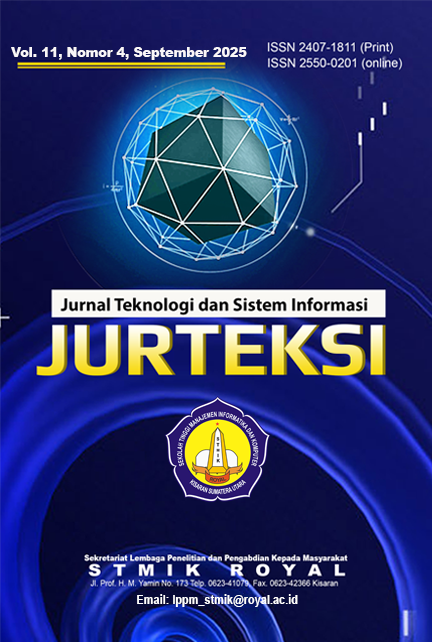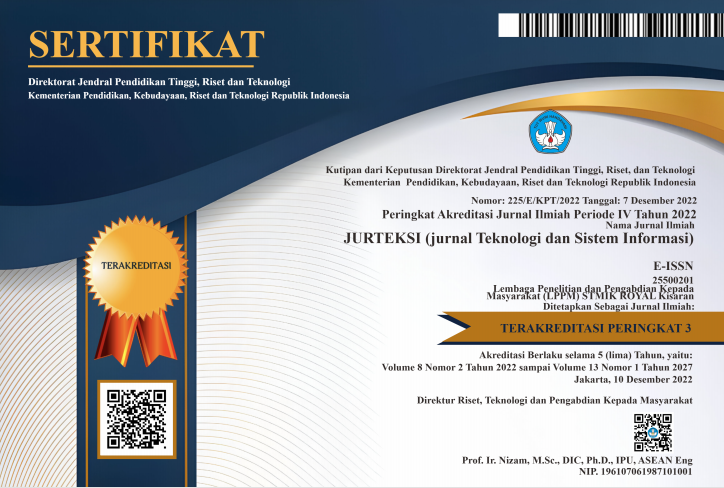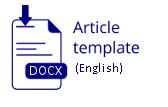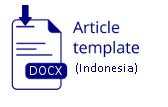DEVELOPMENT OF A QR CODE-BASED WEBAR TO DIGITIZE LOCAL WISDOM AS AN EFFORT TO INCREASE TOURIST ATTRACTION IN BORDER AREAS
Abstract
Abstract: Current technological developments play a crucial role in driving the tourism industry, one of which is the utilization of technology. However, tourist attractions in border areas face challenges such as limited access to digital information and a lack of interactive media to present local wisdom such as history, customs, and culture. This study aims to develop and implement a QR Code-based Web-based Augmented Reality (WebAR) to digitize local wisdom at tourist attractions, making information more engaging and accessible to tourists. The research methodology adopted three approaches: UCD (User-Centered Design), Agile methods, and TAM (Technology Acceptance Model). This platform contains the local wisdom of two tourist villages in the border area, namely Sebujit Village and Jagoi Babang Village. The results of testing and evaluation using multiple linear regression and SEM-PLS methods on 45 respondents showed that the WebAR technology acceptance model was significant (F = 6.583; p < 0.001). User Attitude (ATU) is a key variable that significantly influences Intention to Use (BI) (β=0.429; p=0.001), while Ease of Use (PEOU) and Benefit (PU) indirectly influence BI through ATU. As additional validation, the classification test yielded an accuracy of 88.90% and an F1-score of 0.941, confirming that QR Code-based WebAR is effective and well-received as a digital information and promotion medium for local wisdom in border areas.
Keywords: border areas; local wisdom; qr code; tourist attractions; web augmented reality.
Abstrak: Perkembangan teknologi saat ini memiliki peran penting dalam mendorong industri pariwisata, salah satunya dengan pemanfaatan teknologi. Namun, objek wisata di daerah perbatasan menghadapi tantangan seperti keterbatasan akses informasi digital dan kurangnya media interaktif untuk menyajikan kearifan lokal seperti sejarah, adat istiadat, dan budaya. Penelitian ini bertujuan untuk mengembangkan dan mengimplementasikan Web-based Augmented Reality (WebAR) berbasis QR Code untuk digitalisasi kearifan lokal objek wisata, menjadikan informasi lebih menarik dan mudah diakses bagi wisatawan. Metodologi penelitian mengadopsi tiga pendekatan, UCD (User-Centered Design), metode Agile, dan TAM (Technology Acceptance Model). Platform ini memuat kearifan lokal dua desa wisata di daerah perbatasan, yaitu Desa Sebujit dan Desa Jagoi Babang. Hasil pengujian dan evaluasi dengan metode regresi linier berganda dan SEM-PLS pada 45 responden menunjukkan bahwa model penerimaan teknologi WebAR ini signifikan (F = 6.583; p < 0.001). Sikap Pengguna (ATU) menjadi variabel kunci yang berpengaruh signifikan terhadap Niat Penggunaan (BI) (β=0.429; p=0.001), sementara Kemudahan Penggunaan (PEOU) dan Manfaat (PU) memengaruhi BI secara tidak langsung melalui ATU. Sebagai validasi tambahan, uji klasifikasi menghasilkan akurasi 88,90% dan F1-score 0,941, yang menegaskan bahwa WebAR berbasis Kode QR efektif dan dapat diterima dengan baik sebagai media informasi dan promosi digital kearifan lokal di wilayah perbatasan.
Kata Kunci: daerah perbatasan; kearifan lokal; qr code; web augmented reality.
References
BK Vuspitasari, Local Wisdom as a Tourist Attraction. Ponorogo: UWAIS Inspirasi Indonesia, 2024. [Online]. Available: https://books.google.co.id/books?hl=en&lr=&id=cY9BEQAAQBAJ&oi=fnd&pg=PA1&dq=Creative Tourism Information System Based on Augmented Reality to Preserve Local Wisdom of Tourist Attractions in Border Areas&ots=hlF6Cty-_Q&sig=ET31EVk0YrIwvCvHX27PkP4xlhw&r
Ministry Of Tourism And Creative Economy, “Outlook on Tourism and the Creative Economy,” Jakarta, 2023. [Online]. Available: https://www.kemenparekraf.go.id/hasil-pencarian/outlook-pariwisata-dan-ekonomi-kreatif-20232024
Indra, Rina, and I. Veriansyah, “Analysis of the Riam Pangar Tourist Attraction, Tujuh Belas District, Bengkayang Regency,” Geo Khatulistiwa J. Educator. Geogr. and Tourism, vol. 2, no. 3, pp. 1–14, 2022.
IKAA Maheswara and IBG Sarasvananda, “PKM: Implementation of Augmented Reality Application for Introduction to Manda Traditions Based on Mobile,” J. Soc. Work Empower., vol. 3, no. 1, pp. 11–18, 2023, doi: 10.58982/jswe.v3i1.511.
F. Muff and HG Fill, M2AR: A Web-based Modeling Environment for the Augmented Reality Workflow Modeling Language, vol. 1, no. 1. Association for Computing Machinery, 2024. doi: 10.1145/3652620.3687779.
BK Vuspitasari, Creative Economy and Tourism. Sumedang West Java: megapress, 2023.
HM Pohan, A. Syaputra, FS Harahap, D. Yunita, RA Siregar, and A. Ben Mabrouk, "Development of an Augmented Reality-Based Practicum E-Module Integrated with Local Wisdom of Salak Fruit," vol. 2, no. December, pp. 124–135, 2024.
HA Hussein, MH Ali, M. Al-Hashimi, NT Majeed, QA Hameed, and RD Ismael, "The Effect of Web Augmented Reality on Primary Pupils' Achievement in English," Appl. Syst. Innov., vol. 6, no. 1, pp. 1–20, 2023, doi: 10.3390/asi6010018.
K. Karuppasamy, M. Madesh, R. Jaiharini, B. Priyadharshini, and R. Jasvanth, "Interactive Learning through Augmented Reality, Enhancing Textbook Engagement with QR Code-Based 3D Visualizations of Educational Content in the Real World," vol. 10, no. 4, pp. 3754–3764, 2025.
BK Vuspitasari, YN Atlantika, and N. Novianty, “Utilization of Digital in Marketing Rattan Woven Products from Creative Villages on the Border,” EKOMBIS Rev. J. Ilm. Ekon. dan Bisnis, vol. 11, no. 1, pp. 997–1004, 2023, doi: 10.37676/ekombis.v11i1.3106.
N. Wirana and P. Noviyanti, “Analysis and Implementation of Bengkayang Tourism Object Information System Using Object-Oriented Approach,” vol. 3, no. 2, pp. 61–74, 2024.
FLM Horhoruw, P. Noviyanti, Mira, and JP Nadapdap, "Development of Augmented Reality Technology in Tourism as an Effort to Preserve Local Culture," J. Science Info Inform. and Science, vol. 13, no. 03, pp. 882–887, 2023.
M. Cabeleira and CV de Carvalho, “Using Augmented Reality to Improve Touristic Efficacy,” vol. 14, no. 2, pp. 1–19, 2025, doi: https://doi.org/10.3390/computers14020075.
KF McNally and H. Koviland, “A Web-Based Augmented Reality System,” ICST Trans. Scalable Inf. Syst., pp. 1–8, 2024, doi: 10.4108/eetsis.5481.
NM Tuah, WNW Ahmad, RM Andrias, DS Ajor, S. Sura, and ARA Rodzuan, "Assessing the user experience of marker-based 3D WebAR applications using user experience questionnaire," Int. J. Informatics Commun. Technol., vol. 14, no. 1, pp. 31–41, 2025, doi: 10.11591/ijict.v14i1.pp31-41.
G. Taub, A. Elmalech, and N. Aharony, “Trust and attitude toward information presented using augmented reality and other technological means,” Heliyon, vol. 10, no. 4, p. e25944, 2024, doi: 10.1016/j.heliyon.2024.e25944.
ZS Kabir and K. Kang, "The Impact of Augmented Reality Through User-Platform Interactions Towards Continuance Intention with the Effect of User Generation," Information, vol. 15, no. 12, 2024, doi: 10.3390/info15120758.













